Nursing Assignment-Integrated Case Study-Claudia Donaldson
VerifiedAdded on 2023/06/13
|10
|2774
|391
AI Summary
This report applies the principle of patient centered care to develop a care plan in relation to the case study of Mr. Davis. The care plan is developed based on the identification of two actual or potential nursing problems in the case study and the report also gives detail on patient-centered goal for each nursing problems.
Contribute Materials
Your contribution can guide someone’s learning journey. Share your
documents today.
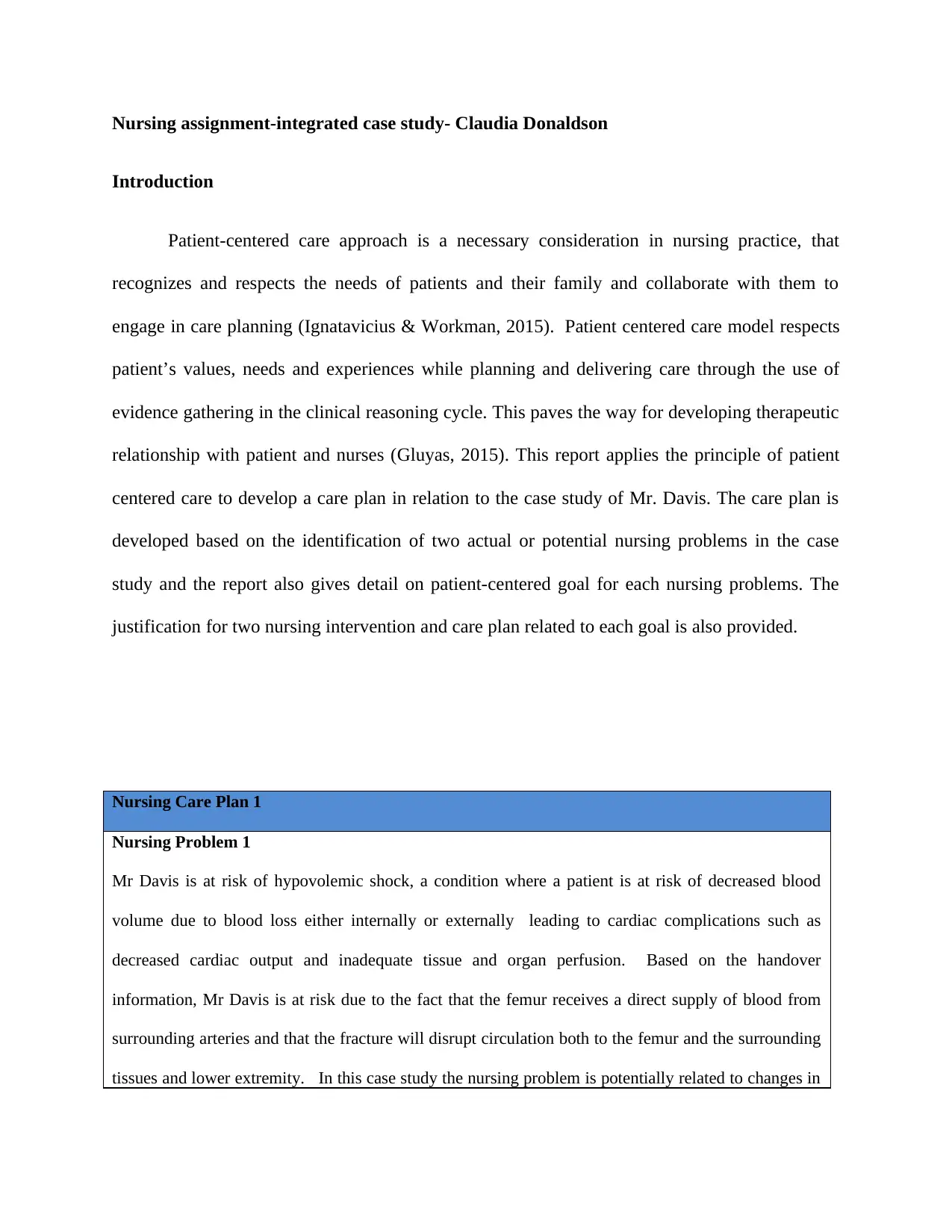
Nursing assignment-integrated case study- Claudia Donaldson
Introduction
Patient-centered care approach is a necessary consideration in nursing practice, that
recognizes and respects the needs of patients and their family and collaborate with them to
engage in care planning (Ignatavicius & Workman, 2015). Patient centered care model respects
patient’s values, needs and experiences while planning and delivering care through the use of
evidence gathering in the clinical reasoning cycle. This paves the way for developing therapeutic
relationship with patient and nurses (Gluyas, 2015). This report applies the principle of patient
centered care to develop a care plan in relation to the case study of Mr. Davis. The care plan is
developed based on the identification of two actual or potential nursing problems in the case
study and the report also gives detail on patient-centered goal for each nursing problems. The
justification for two nursing intervention and care plan related to each goal is also provided.
Nursing Care Plan 1
Nursing Problem 1
Mr Davis is at risk of hypovolemic shock, a condition where a patient is at risk of decreased blood
volume due to blood loss either internally or externally leading to cardiac complications such as
decreased cardiac output and inadequate tissue and organ perfusion. Based on the handover
information, Mr Davis is at risk due to the fact that the femur receives a direct supply of blood from
surrounding arteries and that the fracture will disrupt circulation both to the femur and the surrounding
tissues and lower extremity. In this case study the nursing problem is potentially related to changes in
Introduction
Patient-centered care approach is a necessary consideration in nursing practice, that
recognizes and respects the needs of patients and their family and collaborate with them to
engage in care planning (Ignatavicius & Workman, 2015). Patient centered care model respects
patient’s values, needs and experiences while planning and delivering care through the use of
evidence gathering in the clinical reasoning cycle. This paves the way for developing therapeutic
relationship with patient and nurses (Gluyas, 2015). This report applies the principle of patient
centered care to develop a care plan in relation to the case study of Mr. Davis. The care plan is
developed based on the identification of two actual or potential nursing problems in the case
study and the report also gives detail on patient-centered goal for each nursing problems. The
justification for two nursing intervention and care plan related to each goal is also provided.
Nursing Care Plan 1
Nursing Problem 1
Mr Davis is at risk of hypovolemic shock, a condition where a patient is at risk of decreased blood
volume due to blood loss either internally or externally leading to cardiac complications such as
decreased cardiac output and inadequate tissue and organ perfusion. Based on the handover
information, Mr Davis is at risk due to the fact that the femur receives a direct supply of blood from
surrounding arteries and that the fracture will disrupt circulation both to the femur and the surrounding
tissues and lower extremity. In this case study the nursing problem is potentially related to changes in
Secure Best Marks with AI Grader
Need help grading? Try our AI Grader for instant feedback on your assignments.
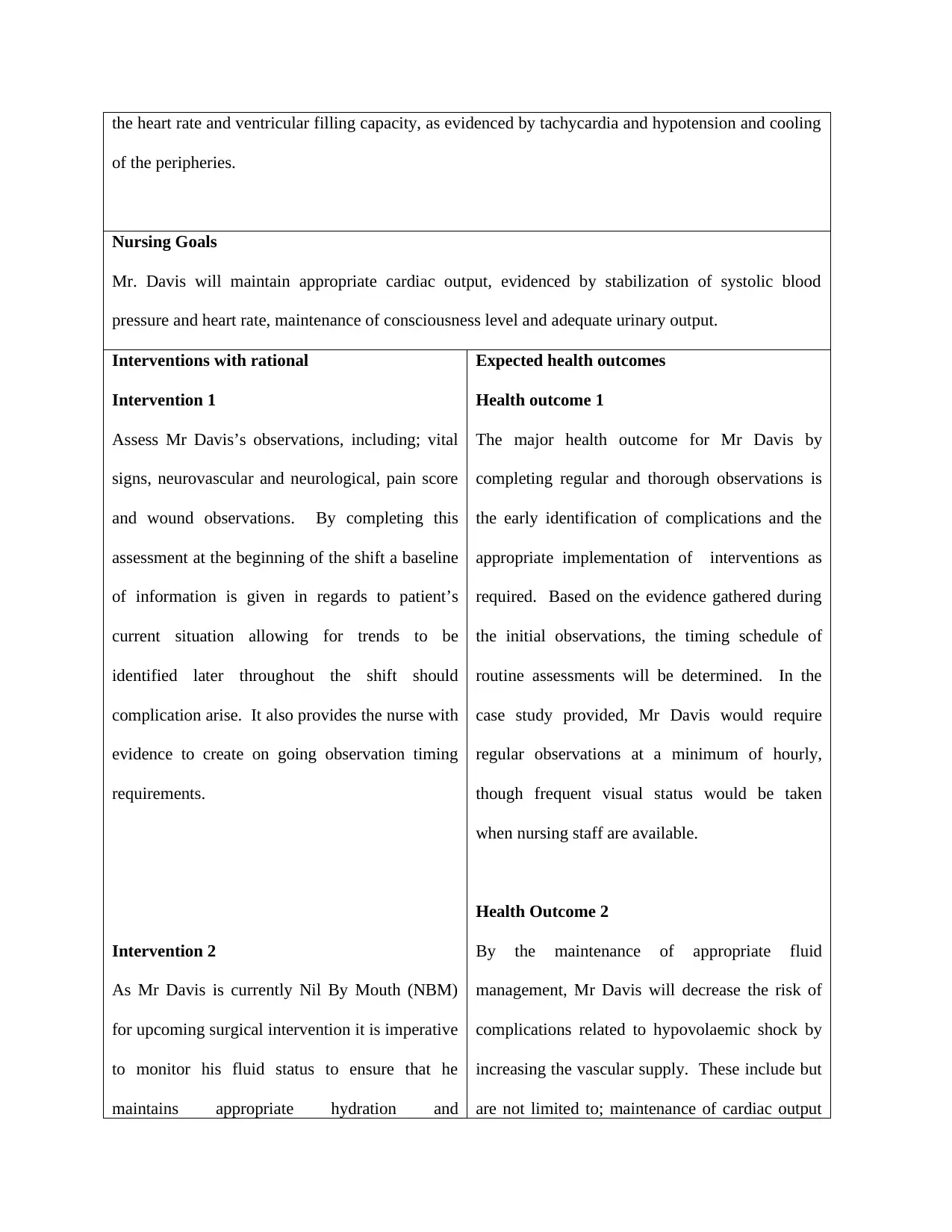
the heart rate and ventricular filling capacity, as evidenced by tachycardia and hypotension and cooling
of the peripheries.
Nursing Goals
Mr. Davis will maintain appropriate cardiac output, evidenced by stabilization of systolic blood
pressure and heart rate, maintenance of consciousness level and adequate urinary output.
Interventions with rational
Intervention 1
Assess Mr Davis’s observations, including; vital
signs, neurovascular and neurological, pain score
and wound observations. By completing this
assessment at the beginning of the shift a baseline
of information is given in regards to patient’s
current situation allowing for trends to be
identified later throughout the shift should
complication arise. It also provides the nurse with
evidence to create on going observation timing
requirements.
Intervention 2
As Mr Davis is currently Nil By Mouth (NBM)
for upcoming surgical intervention it is imperative
to monitor his fluid status to ensure that he
maintains appropriate hydration and
Expected health outcomes
Health outcome 1
The major health outcome for Mr Davis by
completing regular and thorough observations is
the early identification of complications and the
appropriate implementation of interventions as
required. Based on the evidence gathered during
the initial observations, the timing schedule of
routine assessments will be determined. In the
case study provided, Mr Davis would require
regular observations at a minimum of hourly,
though frequent visual status would be taken
when nursing staff are available.
Health Outcome 2
By the maintenance of appropriate fluid
management, Mr Davis will decrease the risk of
complications related to hypovolaemic shock by
increasing the vascular supply. These include but
are not limited to; maintenance of cardiac output
of the peripheries.
Nursing Goals
Mr. Davis will maintain appropriate cardiac output, evidenced by stabilization of systolic blood
pressure and heart rate, maintenance of consciousness level and adequate urinary output.
Interventions with rational
Intervention 1
Assess Mr Davis’s observations, including; vital
signs, neurovascular and neurological, pain score
and wound observations. By completing this
assessment at the beginning of the shift a baseline
of information is given in regards to patient’s
current situation allowing for trends to be
identified later throughout the shift should
complication arise. It also provides the nurse with
evidence to create on going observation timing
requirements.
Intervention 2
As Mr Davis is currently Nil By Mouth (NBM)
for upcoming surgical intervention it is imperative
to monitor his fluid status to ensure that he
maintains appropriate hydration and
Expected health outcomes
Health outcome 1
The major health outcome for Mr Davis by
completing regular and thorough observations is
the early identification of complications and the
appropriate implementation of interventions as
required. Based on the evidence gathered during
the initial observations, the timing schedule of
routine assessments will be determined. In the
case study provided, Mr Davis would require
regular observations at a minimum of hourly,
though frequent visual status would be taken
when nursing staff are available.
Health Outcome 2
By the maintenance of appropriate fluid
management, Mr Davis will decrease the risk of
complications related to hypovolaemic shock by
increasing the vascular supply. These include but
are not limited to; maintenance of cardiac output
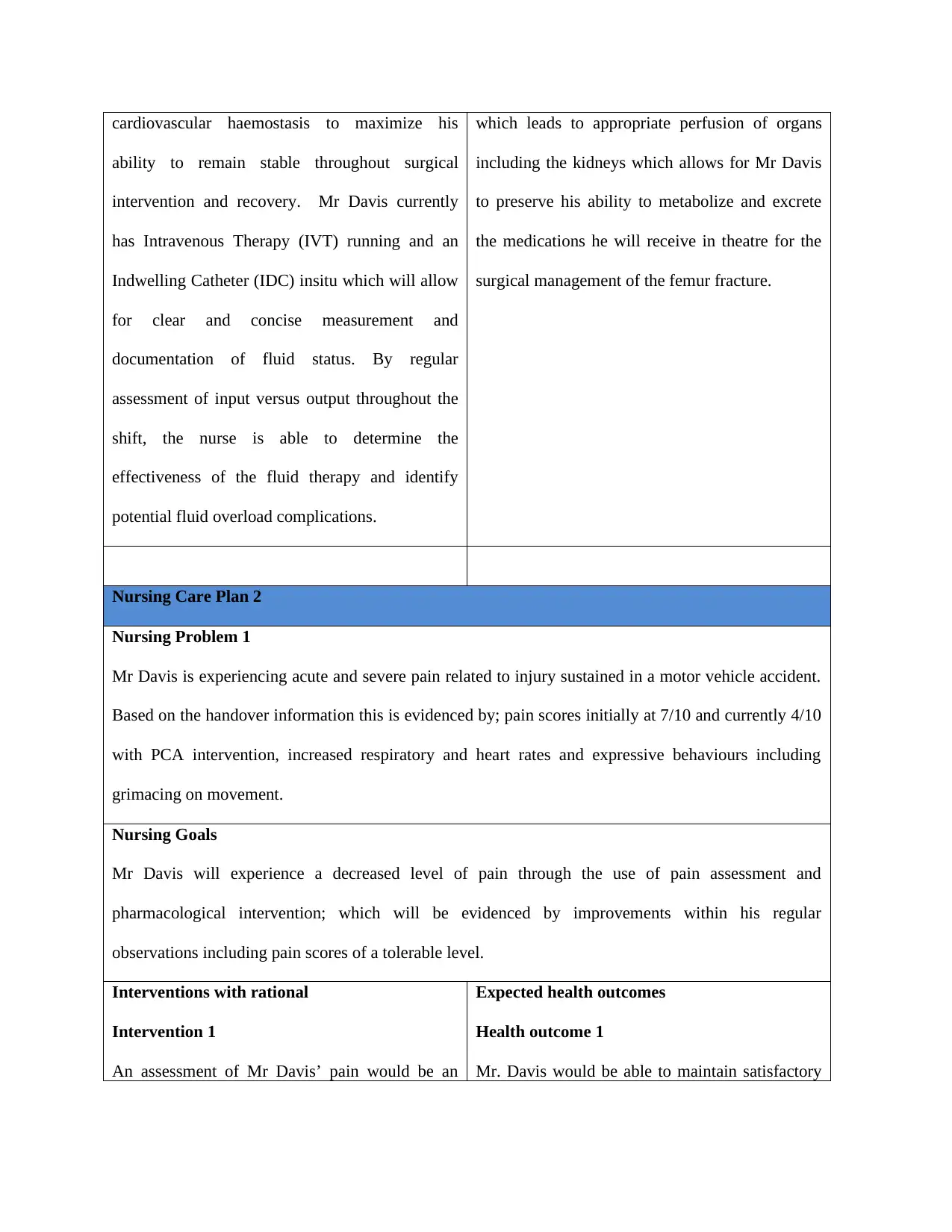
cardiovascular haemostasis to maximize his
ability to remain stable throughout surgical
intervention and recovery. Mr Davis currently
has Intravenous Therapy (IVT) running and an
Indwelling Catheter (IDC) insitu which will allow
for clear and concise measurement and
documentation of fluid status. By regular
assessment of input versus output throughout the
shift, the nurse is able to determine the
effectiveness of the fluid therapy and identify
potential fluid overload complications.
which leads to appropriate perfusion of organs
including the kidneys which allows for Mr Davis
to preserve his ability to metabolize and excrete
the medications he will receive in theatre for the
surgical management of the femur fracture.
Nursing Care Plan 2
Nursing Problem 1
Mr Davis is experiencing acute and severe pain related to injury sustained in a motor vehicle accident.
Based on the handover information this is evidenced by; pain scores initially at 7/10 and currently 4/10
with PCA intervention, increased respiratory and heart rates and expressive behaviours including
grimacing on movement.
Nursing Goals
Mr Davis will experience a decreased level of pain through the use of pain assessment and
pharmacological intervention; which will be evidenced by improvements within his regular
observations including pain scores of a tolerable level.
Interventions with rational
Intervention 1
An assessment of Mr Davis’ pain would be an
Expected health outcomes
Health outcome 1
Mr. Davis would be able to maintain satisfactory
ability to remain stable throughout surgical
intervention and recovery. Mr Davis currently
has Intravenous Therapy (IVT) running and an
Indwelling Catheter (IDC) insitu which will allow
for clear and concise measurement and
documentation of fluid status. By regular
assessment of input versus output throughout the
shift, the nurse is able to determine the
effectiveness of the fluid therapy and identify
potential fluid overload complications.
which leads to appropriate perfusion of organs
including the kidneys which allows for Mr Davis
to preserve his ability to metabolize and excrete
the medications he will receive in theatre for the
surgical management of the femur fracture.
Nursing Care Plan 2
Nursing Problem 1
Mr Davis is experiencing acute and severe pain related to injury sustained in a motor vehicle accident.
Based on the handover information this is evidenced by; pain scores initially at 7/10 and currently 4/10
with PCA intervention, increased respiratory and heart rates and expressive behaviours including
grimacing on movement.
Nursing Goals
Mr Davis will experience a decreased level of pain through the use of pain assessment and
pharmacological intervention; which will be evidenced by improvements within his regular
observations including pain scores of a tolerable level.
Interventions with rational
Intervention 1
An assessment of Mr Davis’ pain would be an
Expected health outcomes
Health outcome 1
Mr. Davis would be able to maintain satisfactory
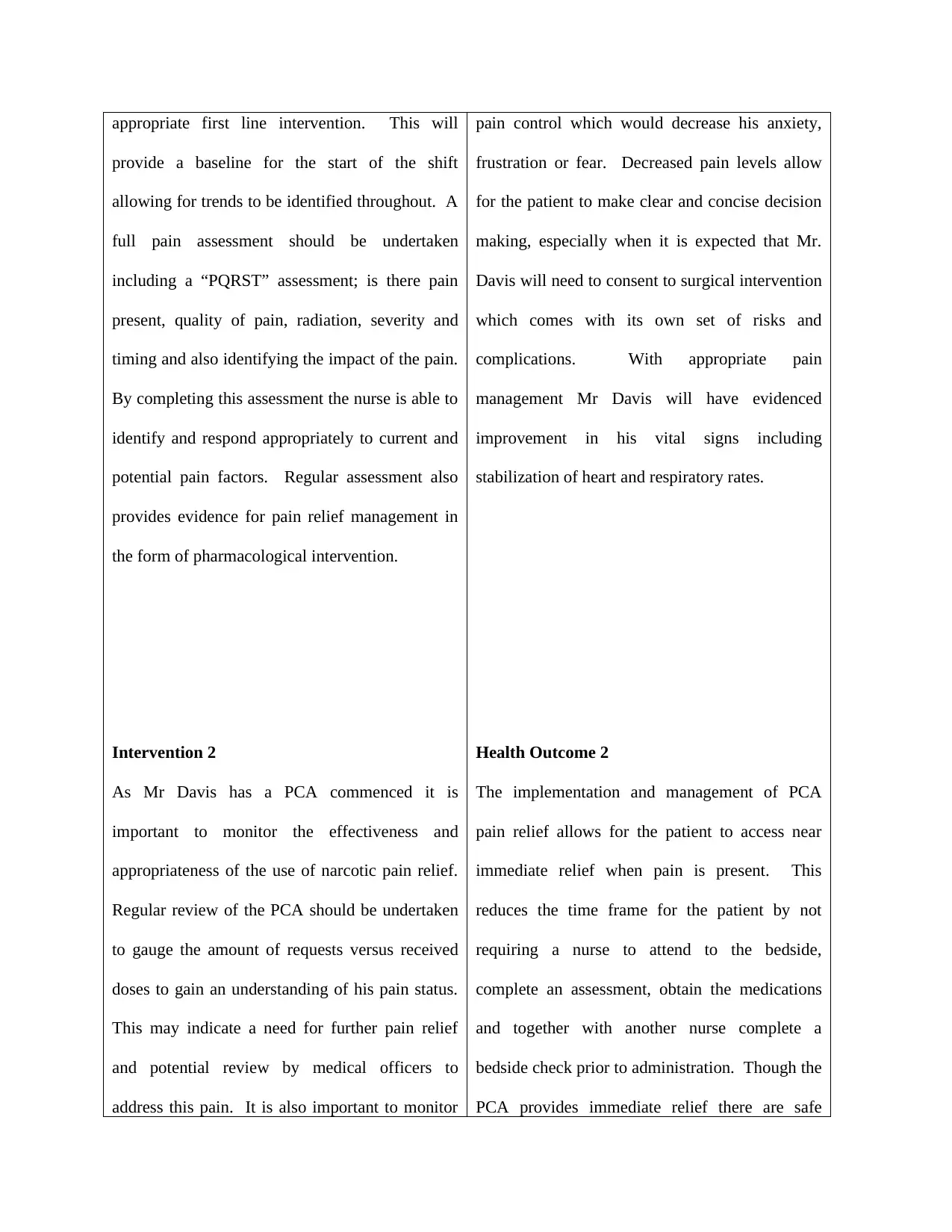
appropriate first line intervention. This will
provide a baseline for the start of the shift
allowing for trends to be identified throughout. A
full pain assessment should be undertaken
including a “PQRST” assessment; is there pain
present, quality of pain, radiation, severity and
timing and also identifying the impact of the pain.
By completing this assessment the nurse is able to
identify and respond appropriately to current and
potential pain factors. Regular assessment also
provides evidence for pain relief management in
the form of pharmacological intervention.
Intervention 2
As Mr Davis has a PCA commenced it is
important to monitor the effectiveness and
appropriateness of the use of narcotic pain relief.
Regular review of the PCA should be undertaken
to gauge the amount of requests versus received
doses to gain an understanding of his pain status.
This may indicate a need for further pain relief
and potential review by medical officers to
address this pain. It is also important to monitor
pain control which would decrease his anxiety,
frustration or fear. Decreased pain levels allow
for the patient to make clear and concise decision
making, especially when it is expected that Mr.
Davis will need to consent to surgical intervention
which comes with its own set of risks and
complications. With appropriate pain
management Mr Davis will have evidenced
improvement in his vital signs including
stabilization of heart and respiratory rates.
Health Outcome 2
The implementation and management of PCA
pain relief allows for the patient to access near
immediate relief when pain is present. This
reduces the time frame for the patient by not
requiring a nurse to attend to the bedside,
complete an assessment, obtain the medications
and together with another nurse complete a
bedside check prior to administration. Though the
PCA provides immediate relief there are safe
provide a baseline for the start of the shift
allowing for trends to be identified throughout. A
full pain assessment should be undertaken
including a “PQRST” assessment; is there pain
present, quality of pain, radiation, severity and
timing and also identifying the impact of the pain.
By completing this assessment the nurse is able to
identify and respond appropriately to current and
potential pain factors. Regular assessment also
provides evidence for pain relief management in
the form of pharmacological intervention.
Intervention 2
As Mr Davis has a PCA commenced it is
important to monitor the effectiveness and
appropriateness of the use of narcotic pain relief.
Regular review of the PCA should be undertaken
to gauge the amount of requests versus received
doses to gain an understanding of his pain status.
This may indicate a need for further pain relief
and potential review by medical officers to
address this pain. It is also important to monitor
pain control which would decrease his anxiety,
frustration or fear. Decreased pain levels allow
for the patient to make clear and concise decision
making, especially when it is expected that Mr.
Davis will need to consent to surgical intervention
which comes with its own set of risks and
complications. With appropriate pain
management Mr Davis will have evidenced
improvement in his vital signs including
stabilization of heart and respiratory rates.
Health Outcome 2
The implementation and management of PCA
pain relief allows for the patient to access near
immediate relief when pain is present. This
reduces the time frame for the patient by not
requiring a nurse to attend to the bedside,
complete an assessment, obtain the medications
and together with another nurse complete a
bedside check prior to administration. Though the
PCA provides immediate relief there are safe
Secure Best Marks with AI Grader
Need help grading? Try our AI Grader for instant feedback on your assignments.
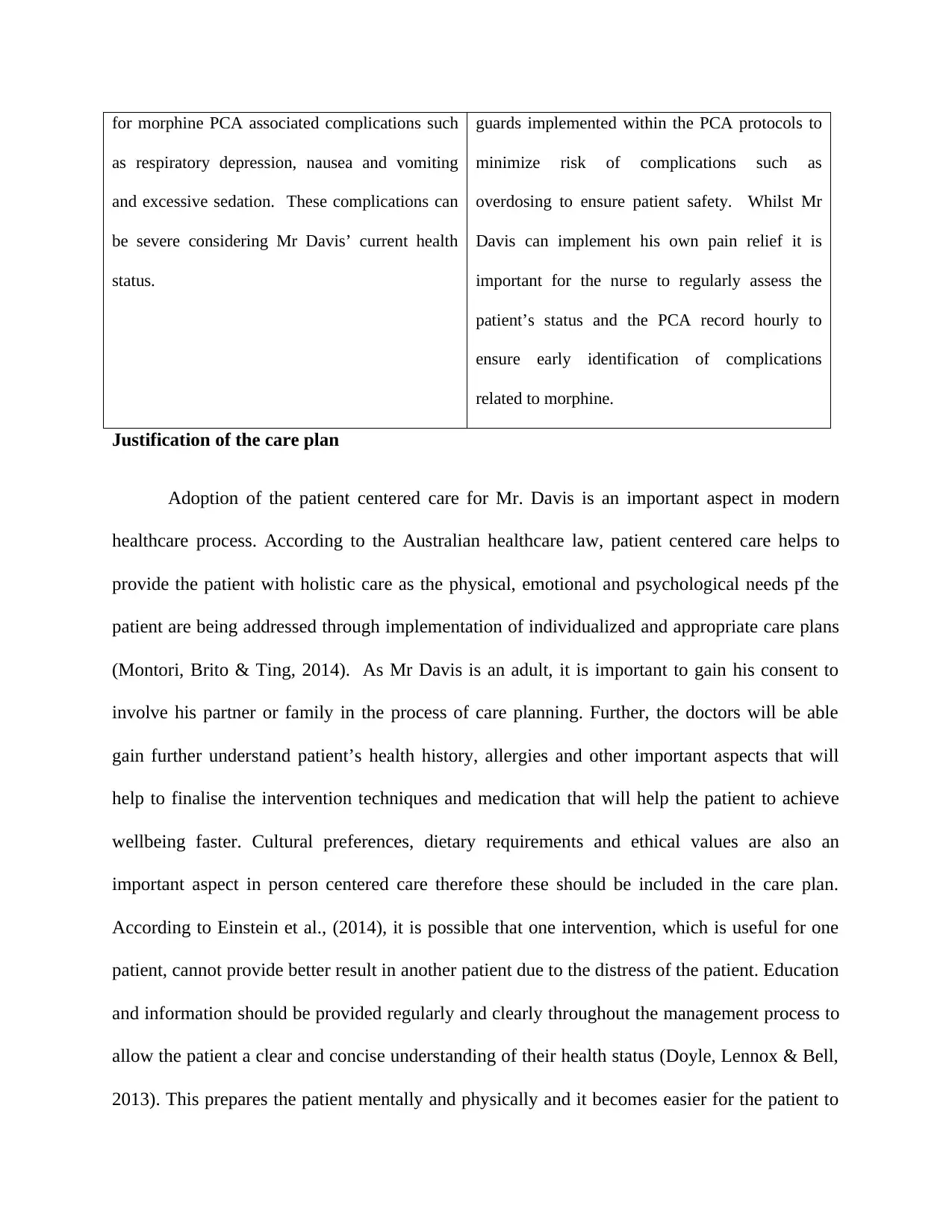
for morphine PCA associated complications such
as respiratory depression, nausea and vomiting
and excessive sedation. These complications can
be severe considering Mr Davis’ current health
status.
guards implemented within the PCA protocols to
minimize risk of complications such as
overdosing to ensure patient safety. Whilst Mr
Davis can implement his own pain relief it is
important for the nurse to regularly assess the
patient’s status and the PCA record hourly to
ensure early identification of complications
related to morphine.
Justification of the care plan
Adoption of the patient centered care for Mr. Davis is an important aspect in modern
healthcare process. According to the Australian healthcare law, patient centered care helps to
provide the patient with holistic care as the physical, emotional and psychological needs pf the
patient are being addressed through implementation of individualized and appropriate care plans
(Montori, Brito & Ting, 2014). As Mr Davis is an adult, it is important to gain his consent to
involve his partner or family in the process of care planning. Further, the doctors will be able
gain further understand patient’s health history, allergies and other important aspects that will
help to finalise the intervention techniques and medication that will help the patient to achieve
wellbeing faster. Cultural preferences, dietary requirements and ethical values are also an
important aspect in person centered care therefore these should be included in the care plan.
According to Einstein et al., (2014), it is possible that one intervention, which is useful for one
patient, cannot provide better result in another patient due to the distress of the patient. Education
and information should be provided regularly and clearly throughout the management process to
allow the patient a clear and concise understanding of their health status (Doyle, Lennox & Bell,
2013). This prepares the patient mentally and physically and it becomes easier for the patient to
as respiratory depression, nausea and vomiting
and excessive sedation. These complications can
be severe considering Mr Davis’ current health
status.
guards implemented within the PCA protocols to
minimize risk of complications such as
overdosing to ensure patient safety. Whilst Mr
Davis can implement his own pain relief it is
important for the nurse to regularly assess the
patient’s status and the PCA record hourly to
ensure early identification of complications
related to morphine.
Justification of the care plan
Adoption of the patient centered care for Mr. Davis is an important aspect in modern
healthcare process. According to the Australian healthcare law, patient centered care helps to
provide the patient with holistic care as the physical, emotional and psychological needs pf the
patient are being addressed through implementation of individualized and appropriate care plans
(Montori, Brito & Ting, 2014). As Mr Davis is an adult, it is important to gain his consent to
involve his partner or family in the process of care planning. Further, the doctors will be able
gain further understand patient’s health history, allergies and other important aspects that will
help to finalise the intervention techniques and medication that will help the patient to achieve
wellbeing faster. Cultural preferences, dietary requirements and ethical values are also an
important aspect in person centered care therefore these should be included in the care plan.
According to Einstein et al., (2014), it is possible that one intervention, which is useful for one
patient, cannot provide better result in another patient due to the distress of the patient. Education
and information should be provided regularly and clearly throughout the management process to
allow the patient a clear and concise understanding of their health status (Doyle, Lennox & Bell,
2013). This prepares the patient mentally and physically and it becomes easier for the patient to
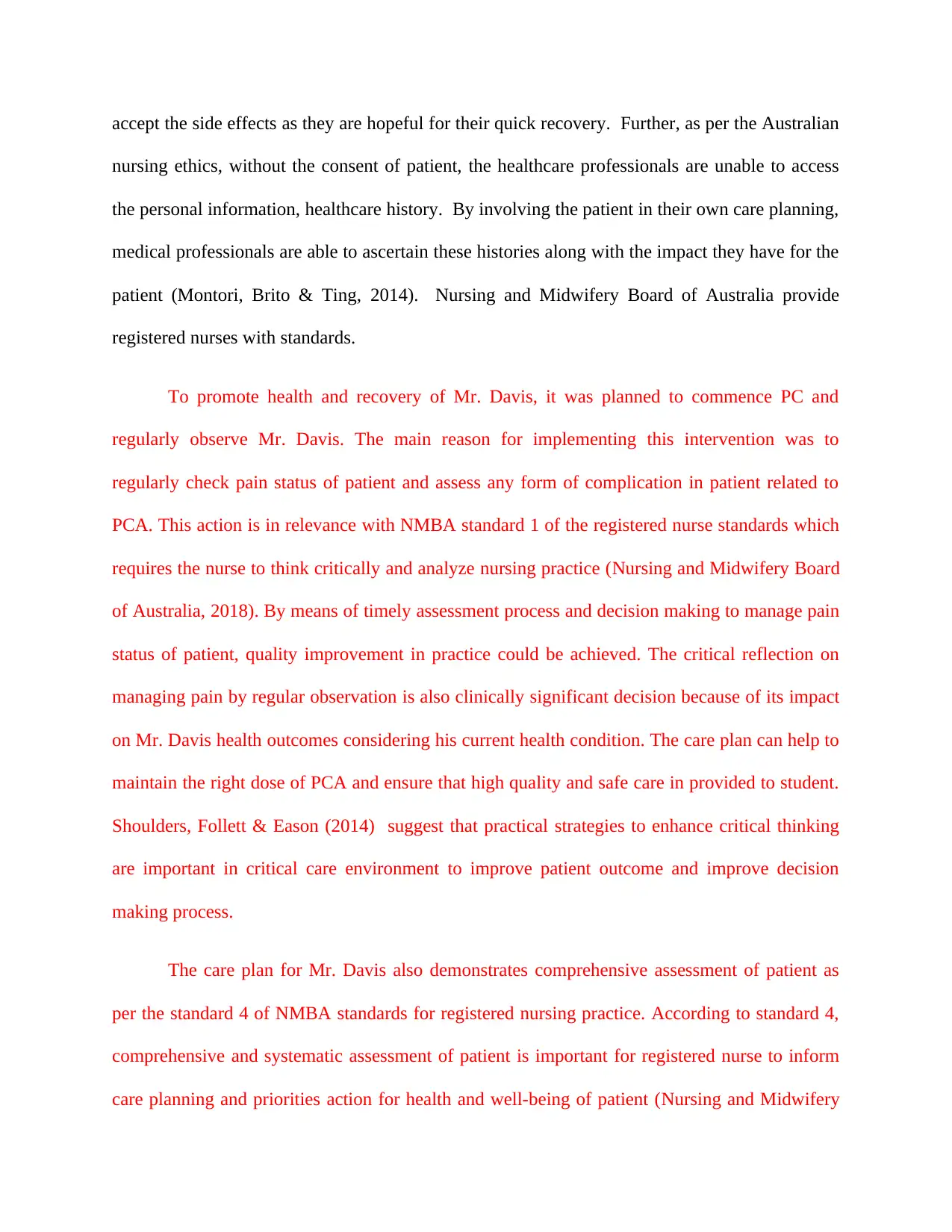
accept the side effects as they are hopeful for their quick recovery. Further, as per the Australian
nursing ethics, without the consent of patient, the healthcare professionals are unable to access
the personal information, healthcare history. By involving the patient in their own care planning,
medical professionals are able to ascertain these histories along with the impact they have for the
patient (Montori, Brito & Ting, 2014). Nursing and Midwifery Board of Australia provide
registered nurses with standards.
To promote health and recovery of Mr. Davis, it was planned to commence PC and
regularly observe Mr. Davis. The main reason for implementing this intervention was to
regularly check pain status of patient and assess any form of complication in patient related to
PCA. This action is in relevance with NMBA standard 1 of the registered nurse standards which
requires the nurse to think critically and analyze nursing practice (Nursing and Midwifery Board
of Australia, 2018). By means of timely assessment process and decision making to manage pain
status of patient, quality improvement in practice could be achieved. The critical reflection on
managing pain by regular observation is also clinically significant decision because of its impact
on Mr. Davis health outcomes considering his current health condition. The care plan can help to
maintain the right dose of PCA and ensure that high quality and safe care in provided to student.
Shoulders, Follett & Eason (2014) suggest that practical strategies to enhance critical thinking
are important in critical care environment to improve patient outcome and improve decision
making process.
The care plan for Mr. Davis also demonstrates comprehensive assessment of patient as
per the standard 4 of NMBA standards for registered nursing practice. According to standard 4,
comprehensive and systematic assessment of patient is important for registered nurse to inform
care planning and priorities action for health and well-being of patient (Nursing and Midwifery
nursing ethics, without the consent of patient, the healthcare professionals are unable to access
the personal information, healthcare history. By involving the patient in their own care planning,
medical professionals are able to ascertain these histories along with the impact they have for the
patient (Montori, Brito & Ting, 2014). Nursing and Midwifery Board of Australia provide
registered nurses with standards.
To promote health and recovery of Mr. Davis, it was planned to commence PC and
regularly observe Mr. Davis. The main reason for implementing this intervention was to
regularly check pain status of patient and assess any form of complication in patient related to
PCA. This action is in relevance with NMBA standard 1 of the registered nurse standards which
requires the nurse to think critically and analyze nursing practice (Nursing and Midwifery Board
of Australia, 2018). By means of timely assessment process and decision making to manage pain
status of patient, quality improvement in practice could be achieved. The critical reflection on
managing pain by regular observation is also clinically significant decision because of its impact
on Mr. Davis health outcomes considering his current health condition. The care plan can help to
maintain the right dose of PCA and ensure that high quality and safe care in provided to student.
Shoulders, Follett & Eason (2014) suggest that practical strategies to enhance critical thinking
are important in critical care environment to improve patient outcome and improve decision
making process.
The care plan for Mr. Davis also demonstrates comprehensive assessment of patient as
per the standard 4 of NMBA standards for registered nursing practice. According to standard 4,
comprehensive and systematic assessment of patient is important for registered nurse to inform
care planning and priorities action for health and well-being of patient (Nursing and Midwifery
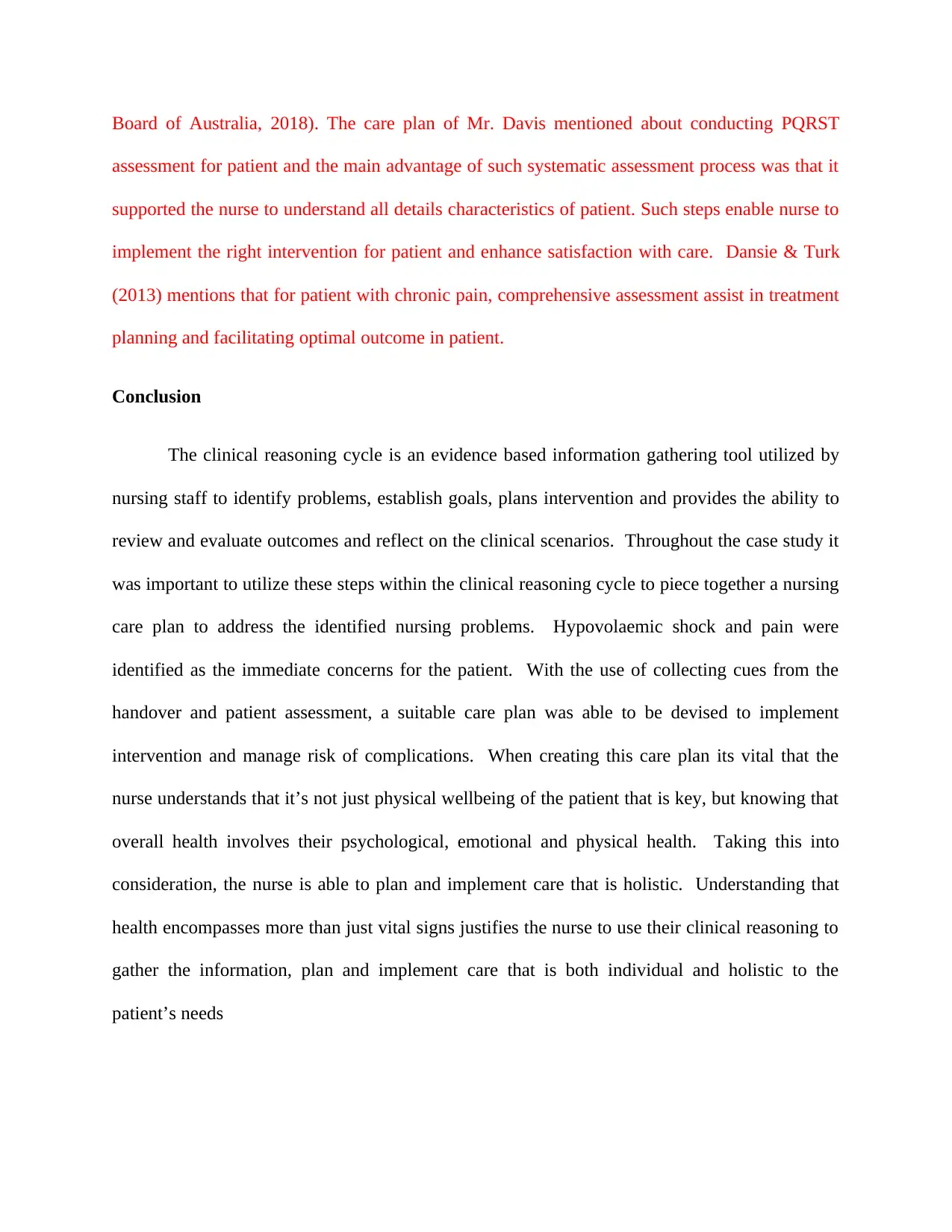
Board of Australia, 2018). The care plan of Mr. Davis mentioned about conducting PQRST
assessment for patient and the main advantage of such systematic assessment process was that it
supported the nurse to understand all details characteristics of patient. Such steps enable nurse to
implement the right intervention for patient and enhance satisfaction with care. Dansie & Turk
(2013) mentions that for patient with chronic pain, comprehensive assessment assist in treatment
planning and facilitating optimal outcome in patient.
Conclusion
The clinical reasoning cycle is an evidence based information gathering tool utilized by
nursing staff to identify problems, establish goals, plans intervention and provides the ability to
review and evaluate outcomes and reflect on the clinical scenarios. Throughout the case study it
was important to utilize these steps within the clinical reasoning cycle to piece together a nursing
care plan to address the identified nursing problems. Hypovolaemic shock and pain were
identified as the immediate concerns for the patient. With the use of collecting cues from the
handover and patient assessment, a suitable care plan was able to be devised to implement
intervention and manage risk of complications. When creating this care plan its vital that the
nurse understands that it’s not just physical wellbeing of the patient that is key, but knowing that
overall health involves their psychological, emotional and physical health. Taking this into
consideration, the nurse is able to plan and implement care that is holistic. Understanding that
health encompasses more than just vital signs justifies the nurse to use their clinical reasoning to
gather the information, plan and implement care that is both individual and holistic to the
patient’s needs
assessment for patient and the main advantage of such systematic assessment process was that it
supported the nurse to understand all details characteristics of patient. Such steps enable nurse to
implement the right intervention for patient and enhance satisfaction with care. Dansie & Turk
(2013) mentions that for patient with chronic pain, comprehensive assessment assist in treatment
planning and facilitating optimal outcome in patient.
Conclusion
The clinical reasoning cycle is an evidence based information gathering tool utilized by
nursing staff to identify problems, establish goals, plans intervention and provides the ability to
review and evaluate outcomes and reflect on the clinical scenarios. Throughout the case study it
was important to utilize these steps within the clinical reasoning cycle to piece together a nursing
care plan to address the identified nursing problems. Hypovolaemic shock and pain were
identified as the immediate concerns for the patient. With the use of collecting cues from the
handover and patient assessment, a suitable care plan was able to be devised to implement
intervention and manage risk of complications. When creating this care plan its vital that the
nurse understands that it’s not just physical wellbeing of the patient that is key, but knowing that
overall health involves their psychological, emotional and physical health. Taking this into
consideration, the nurse is able to plan and implement care that is holistic. Understanding that
health encompasses more than just vital signs justifies the nurse to use their clinical reasoning to
gather the information, plan and implement care that is both individual and holistic to the
patient’s needs
Paraphrase This Document
Need a fresh take? Get an instant paraphrase of this document with our AI Paraphraser
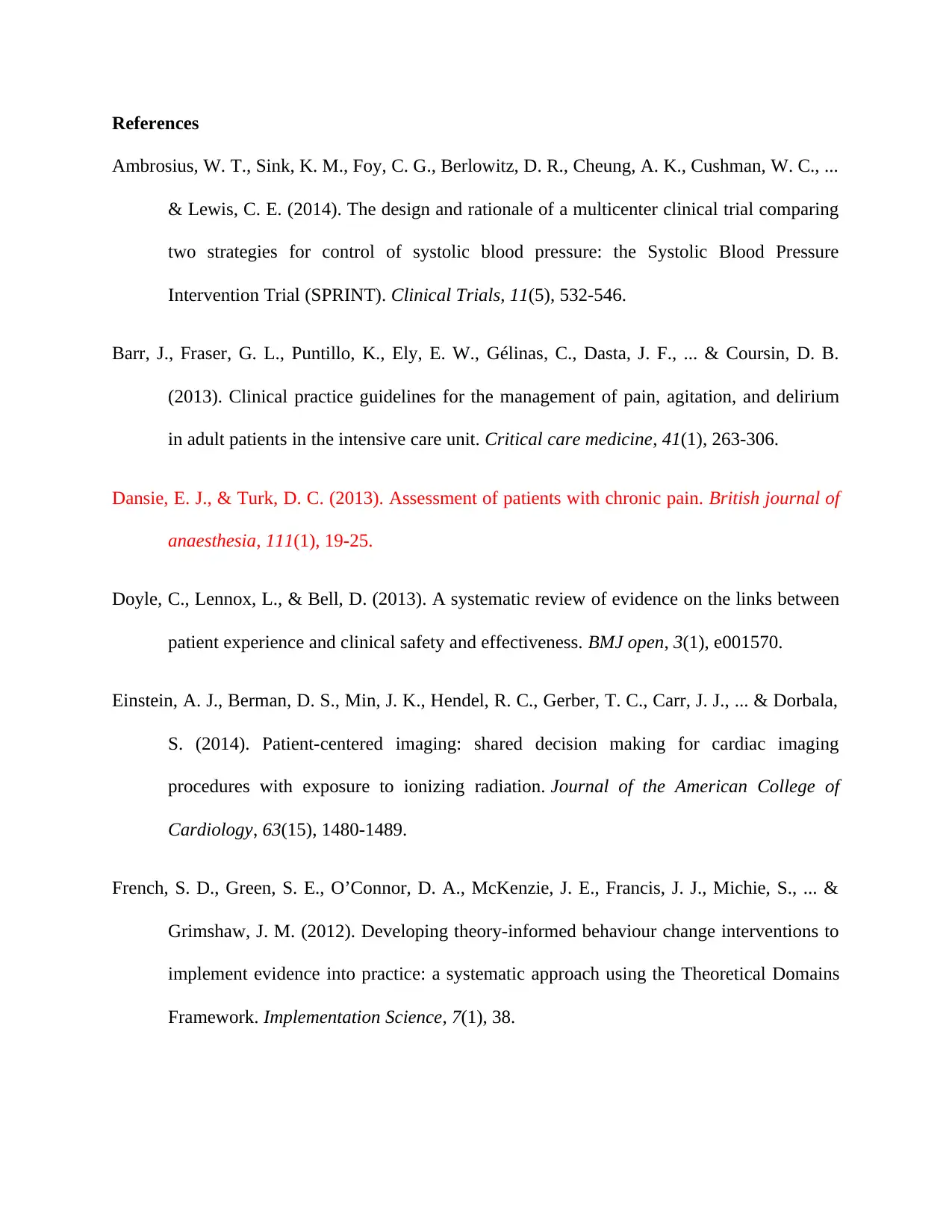
References
Ambrosius, W. T., Sink, K. M., Foy, C. G., Berlowitz, D. R., Cheung, A. K., Cushman, W. C., ...
& Lewis, C. E. (2014). The design and rationale of a multicenter clinical trial comparing
two strategies for control of systolic blood pressure: the Systolic Blood Pressure
Intervention Trial (SPRINT). Clinical Trials, 11(5), 532-546.
Barr, J., Fraser, G. L., Puntillo, K., Ely, E. W., Gélinas, C., Dasta, J. F., ... & Coursin, D. B.
(2013). Clinical practice guidelines for the management of pain, agitation, and delirium
in adult patients in the intensive care unit. Critical care medicine, 41(1), 263-306.
Dansie, E. J., & Turk, D. C. (2013). Assessment of patients with chronic pain. British journal of
anaesthesia, 111(1), 19-25.
Doyle, C., Lennox, L., & Bell, D. (2013). A systematic review of evidence on the links between
patient experience and clinical safety and effectiveness. BMJ open, 3(1), e001570.
Einstein, A. J., Berman, D. S., Min, J. K., Hendel, R. C., Gerber, T. C., Carr, J. J., ... & Dorbala,
S. (2014). Patient-centered imaging: shared decision making for cardiac imaging
procedures with exposure to ionizing radiation. Journal of the American College of
Cardiology, 63(15), 1480-1489.
French, S. D., Green, S. E., O’Connor, D. A., McKenzie, J. E., Francis, J. J., Michie, S., ... &
Grimshaw, J. M. (2012). Developing theory-informed behaviour change interventions to
implement evidence into practice: a systematic approach using the Theoretical Domains
Framework. Implementation Science, 7(1), 38.
Ambrosius, W. T., Sink, K. M., Foy, C. G., Berlowitz, D. R., Cheung, A. K., Cushman, W. C., ...
& Lewis, C. E. (2014). The design and rationale of a multicenter clinical trial comparing
two strategies for control of systolic blood pressure: the Systolic Blood Pressure
Intervention Trial (SPRINT). Clinical Trials, 11(5), 532-546.
Barr, J., Fraser, G. L., Puntillo, K., Ely, E. W., Gélinas, C., Dasta, J. F., ... & Coursin, D. B.
(2013). Clinical practice guidelines for the management of pain, agitation, and delirium
in adult patients in the intensive care unit. Critical care medicine, 41(1), 263-306.
Dansie, E. J., & Turk, D. C. (2013). Assessment of patients with chronic pain. British journal of
anaesthesia, 111(1), 19-25.
Doyle, C., Lennox, L., & Bell, D. (2013). A systematic review of evidence on the links between
patient experience and clinical safety and effectiveness. BMJ open, 3(1), e001570.
Einstein, A. J., Berman, D. S., Min, J. K., Hendel, R. C., Gerber, T. C., Carr, J. J., ... & Dorbala,
S. (2014). Patient-centered imaging: shared decision making for cardiac imaging
procedures with exposure to ionizing radiation. Journal of the American College of
Cardiology, 63(15), 1480-1489.
French, S. D., Green, S. E., O’Connor, D. A., McKenzie, J. E., Francis, J. J., Michie, S., ... &
Grimshaw, J. M. (2012). Developing theory-informed behaviour change interventions to
implement evidence into practice: a systematic approach using the Theoretical Domains
Framework. Implementation Science, 7(1), 38.
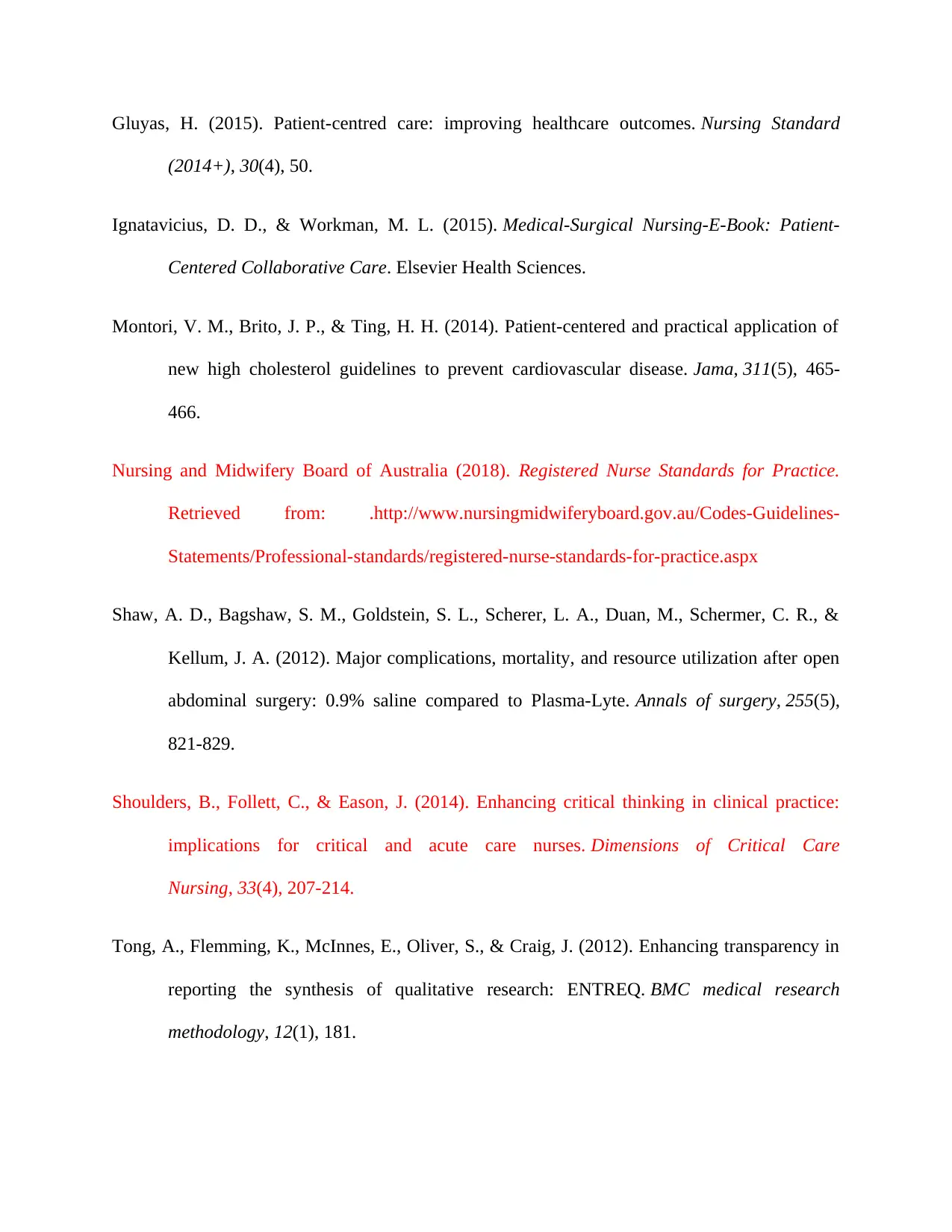
Gluyas, H. (2015). Patient-centred care: improving healthcare outcomes. Nursing Standard
(2014+), 30(4), 50.
Ignatavicius, D. D., & Workman, M. L. (2015). Medical-Surgical Nursing-E-Book: Patient-
Centered Collaborative Care. Elsevier Health Sciences.
Montori, V. M., Brito, J. P., & Ting, H. H. (2014). Patient-centered and practical application of
new high cholesterol guidelines to prevent cardiovascular disease. Jama, 311(5), 465-
466.
Nursing and Midwifery Board of Australia (2018). Registered Nurse Standards for Practice.
Retrieved from: .http://www.nursingmidwiferyboard.gov.au/Codes-Guidelines-
Statements/Professional-standards/registered-nurse-standards-for-practice.aspx
Shaw, A. D., Bagshaw, S. M., Goldstein, S. L., Scherer, L. A., Duan, M., Schermer, C. R., &
Kellum, J. A. (2012). Major complications, mortality, and resource utilization after open
abdominal surgery: 0.9% saline compared to Plasma-Lyte. Annals of surgery, 255(5),
821-829.
Shoulders, B., Follett, C., & Eason, J. (2014). Enhancing critical thinking in clinical practice:
implications for critical and acute care nurses. Dimensions of Critical Care
Nursing, 33(4), 207-214.
Tong, A., Flemming, K., McInnes, E., Oliver, S., & Craig, J. (2012). Enhancing transparency in
reporting the synthesis of qualitative research: ENTREQ. BMC medical research
methodology, 12(1), 181.
(2014+), 30(4), 50.
Ignatavicius, D. D., & Workman, M. L. (2015). Medical-Surgical Nursing-E-Book: Patient-
Centered Collaborative Care. Elsevier Health Sciences.
Montori, V. M., Brito, J. P., & Ting, H. H. (2014). Patient-centered and practical application of
new high cholesterol guidelines to prevent cardiovascular disease. Jama, 311(5), 465-
466.
Nursing and Midwifery Board of Australia (2018). Registered Nurse Standards for Practice.
Retrieved from: .http://www.nursingmidwiferyboard.gov.au/Codes-Guidelines-
Statements/Professional-standards/registered-nurse-standards-for-practice.aspx
Shaw, A. D., Bagshaw, S. M., Goldstein, S. L., Scherer, L. A., Duan, M., Schermer, C. R., &
Kellum, J. A. (2012). Major complications, mortality, and resource utilization after open
abdominal surgery: 0.9% saline compared to Plasma-Lyte. Annals of surgery, 255(5),
821-829.
Shoulders, B., Follett, C., & Eason, J. (2014). Enhancing critical thinking in clinical practice:
implications for critical and acute care nurses. Dimensions of Critical Care
Nursing, 33(4), 207-214.
Tong, A., Flemming, K., McInnes, E., Oliver, S., & Craig, J. (2012). Enhancing transparency in
reporting the synthesis of qualitative research: ENTREQ. BMC medical research
methodology, 12(1), 181.

1 out of 10
Related Documents
Your All-in-One AI-Powered Toolkit for Academic Success.
+13062052269
info@desklib.com
Available 24*7 on WhatsApp / Email
![[object Object]](/_next/static/media/star-bottom.7253800d.svg)
Unlock your academic potential
© 2024 | Zucol Services PVT LTD | All rights reserved.





